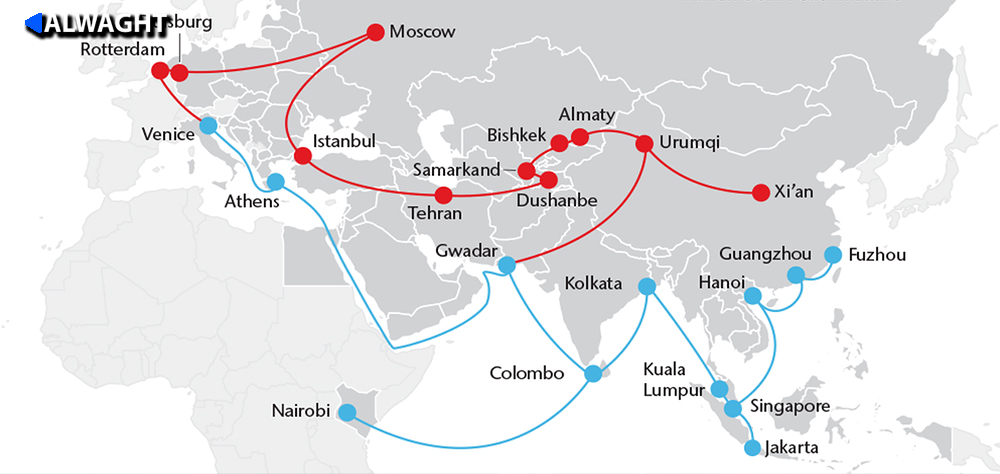Alwaght- Today, transit corridors, including rail, sea, and road are the most important focal points for countries to develop their economic and trade relations with each other. One of the most important routes in the trade and transit of goods in the past and today has been Central Asia.
Its unique position makes West Asia a corridor at the heart of the world. The Central Asian region, as one of the important regional corridors in the field of international transport, is also extremely important for Iran in terms of foreign trade.
The Central Asian international corridors, which are bridges between East Asia and Europe, are also of paramount importance to Iran. Actually, Iran is the most economical route for the transit of goods to Central Asian countries due to access to high seas. Here are the most important trade corridors of Central Asia and their significance to Iran.
KTAI corridor
Crossing Kyrgyzstan, Turkmenistan, Afghanistan, and Iran, the KTAI transit corridor was launched in August last year. It provides a shorter route compared to others and facilitates exports to Central Asian countries via Iran's southern ports. Providing lower costs and shorter distance, the route is commercially justifiable to use, especially for the countries of the Economic Cooperation Organization (ECO). Linking the Central Asian states to the high seas via Iran’s Persian Gulf and Gulf of Oman ports can dramatically increase the Iranian transit revenues.
"Given the desire of Uzbekistan to implement the eTIR project, this corridor can be turned into an eTIR hub. The cooperation of the authorities in the interested countries of the KTAI as well the role played by the guarantee and export organizations, TIR Convention can be extremely instrumental in enhancing the trade between the member states," Behnam Faramarzian, the head of Iran Trade Chamber's International Transportation and TIR Convention Unit said.
New Eurasian Land Bridge
The corridor, also known as the East-West Transit Route, runs from China to Europe and crosses Central Asia. The corridor corresponds to China's "Belt and Road Initiative" and is divided into three northern, central, and southern branches based on the passage through the Caspian Sea. Meanwhile, the southern branch connects to Iran after splitting from the central route from Iranian Tajan to Sarakhs on the border with Turkmenistan. One division goes south and connects to the ports of Shahid Raja'i and Imam Khomeini on the Persian Gulf coasts. The next division goes from Tehran to Tabriz and enters Turkey from Razi border town of Iran and connects to the European road network through the port of Istanbul or other Turkish ports.
North-South corridor
This route links Scandinavian countries and Russia to the Indian Ocean, Persian Gulf, and Southeast Asian states via Iran. A vast part of the ground route crosses Iran. This corridor runs into a number of Central Asia-Europe corridors like TRACECA (Transport Corridor Europe-Caucasus-Asia) and Euclid. It is the shortest, cheapest, and most convenient route for goods transportation between Asia and Europe for businesspeople and transport companies of these two continents. They can easily and safely transport their goods from this route to the Persian Gulf, the Pacific Ocean, Southeast Asia, Russia and the Scandinavian countries, and Northern and Central Europe.
Pan Asian Train Link
This trade route, linking countries across Asia, crosses Singapore, Malaysia, Thailand, Myanmar, Cambodia, Vietnam, and Laos, with one of its branches linking these countries to China. Once this route is complete and countries like India, Pakistan, Iran, and Bangladesh are on board, it will serve as a bridge to Europe.
Compared to maritime transport, the potentials of this corridor have a comparative advantage in terms of a significant reduction in transport time. However, the railways of the countries of the route are unequal in terms of development. Still, it is extremely important for Iran's trade and transportation.
North-East-West corridor
The corridor is primarily meant to provide a combination of east-west transportation between Russia and the eastern coast of North America by crossing the borders of Sweden, Finland and the Tomio-Haparanda region, and also sea transportation from the port of Narvik in Norway. The subordinate branches of this corridor can cross the Iranian territory in the North-South corridor. From the above-mentioned corridors, the southern division of the New Asia-Europe corridor, North-South corridor, and Trans-Asian corridor cross Iran in a show of strategic importance of the country in establishment of a global transportation network.
Scandinavia-Far East corridor (North-West corridor)
This corridor starts from Far East to the Urals, from where it links to the Trans-Siberian Railway Network. Shifting direction to the northwest in the Russian city of Perm, the corridor continues to Arkhangelsk or Murmansk ports of Russia through the Chaiorna region. On the other hand, in the western direction, it moves through Russian railroads to reach Finland ports. Construction of this corridor and possibility of its links to the Russian and the Baltic Sea ports of Finland allows far and deserted regions of Russia to export their products whose main part is the minerals using railways. Though not crossing Iran, the corridor can, in the long run, influence the Iranian-European trade exchanges.



























